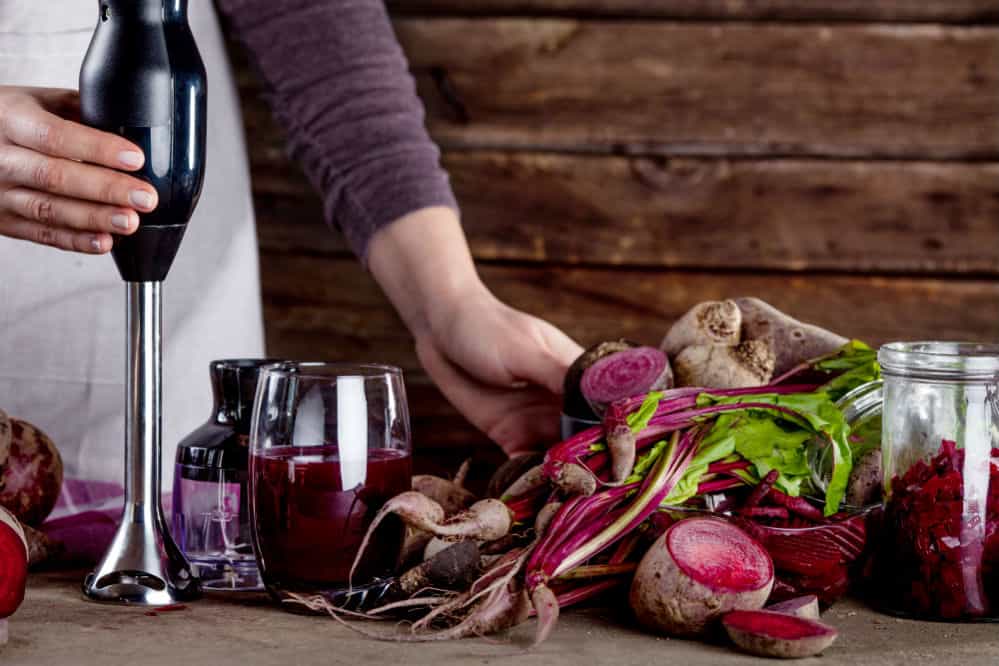Known by different names, such as stick blender, wand blender, Bermixer, or immersion blender, many people often find themselves confused about hand blender. What is hand blender? Where is it used? Do you need one in your kitchen? These are often some of the most common questions asked by many.
In this article, we will answer the most important question, what is it and why you need one in your kitchen. We are sure that most of the people already have one in their kitchen, but if you don’t, you are probably missing out on a very handy and simple tool that can make your life easier in the kitchen.
What Is Hand Blender?
Hand blender was invented in 1950 by Roger Perrinjaquet, a Swiss inventor who patented his idea in March 1950. The gadget was initially named as Bamix. Years later, hand blender or immersion blender become more popular terms.
In simple words, a hand blender is a simple-to-use kitchen gadget that is used for pureeing soups, making single drinks, or blending milkshakes in small quantities. These are utilized when you don’t want to use large electric blenders or when you only need to make something for one person.
Hand Blender vs. Mixer vs. Traditional Blender
Often confused with a mixer, a hand blender is different from a mixer. As the name reflects, a mixer is used to mix or combine ingredients, but a blender is used to turn solids into liquids. This is also one of the reasons why hand blenders are often called liquidizer in some European countries like Great Britain.
For example, you can use a hand blender to turn cooked solid apples into its liquid form, applesauce. Similarly, it is also used to make milkshakes, nose-to-tail lemonade, and other liquid items.
The difference between a hand blender and the most traditional larger blenders is that you don’t have to use one specific container with hand blenders. This means that while you need to put the ingredients to a specific container mostly attached to the traditional blender, you can use hand blenders with any bowl that contains ingredients.
You can also find different variations of hand blenders, as some models also feature a chopping blade that can be used to chop vegetables or fruits like onions or tomatoes.
What Makes Up a Hand Blender?
In most cases, a hand blender is made up of two parts. One is the upper portion, which is used to hold the blender, while the lower part comes in the form of an attachment with sharp blades. There are blades present at the end of the lower part, or shaft that you immerse into the bowl or container when using the hand blender.
In most cases, the blender comes with a complete manufacturer’s instruction that can help you assemble it with ease. For most of the models, the package comes with separate parts, and you need to assemble the upper and lower sections, which will take hardly a minute.
It also comes with an electric motor that powers the fast rotating cutting blades. The power rating of the motor ranges from 120W for home use to 600W and above for commercial hand blenders. Some hand blenders use batteries, while others come with electric cords. Simply put, you can find both cordless and corded options in the market.
In most cases, a standard hand blender for home use has around 6.3 inches long shaft, while hand blenders for commercial or more heavy-duty use can have a shaft length of 21 inches or more.
What Are the Many Benefits of Using Hand Blenders?
So, why do you need one in your kitchen? Here is a quick checklist of the benefits and advantages that a hand blender offers:
- A low-cost, multi-purpose tool that can be used in a wide range of situations
- Compact design that makes it easy to use, clean, and store
- No need to transfer foods to blend when using one
- Easy to make quick, one-person smoothies and shakes right in a glass
How to Use a Hand Blender?
Hand blenders are available in immersion design for a reason. The blending design enables you to blend or cut food right inside the bowl. You don’t have to transfer food to a separate container, so you can use a hand blender with a pot right on the cooking stove while preparing food. This makes it a very handy tool.
Other common uses include blending liquid batters, removing lumps from gravies, processing small amounts of baby food, and smoothing out chunks from pasta sauce. As they are very easy to use and move around, especially if you are using a cordless hand blender, you can also get as creative with them as you can.
Here are some quick recipes to use a hand blender to give you an idea what you can achieve with a hand blender.
A Bonus Recipe!
Combine milk, fresh fruits, ice, and sugar (if needed) in a glass. Just immerse your hand blender into the glass and turn it on. Keep blending the mixture until it gets smooth and all solids convert into liquid. Easy, isn’t it?
Next, put the ingredients for a fruit soup or for a pureed vegetable in the pan right on the stove. After cooking the vegetables or fruits for some time, use the hand blender on soft vegetables or fruits to blend them perfectly for a delicious soup of puree.
You can also use the hand blender in a variety of more situations like making a lump-free gravy, which is often a challenge for even experienced cooks. The use of hand blenders makes it very easy.
The Final Words
We are sure you now have not only a clear idea about what is hand blender, but you are also considering buying a good model for yourself if you don’t already have one.
As mentioned above, a hand blender is a very handy tool that can be used in a variety of situations and make things simpler for you in the kitchen. It is also easy to use and clean and available in a compact design. Above all, it is not an expensive gadget, so why miss out?

